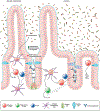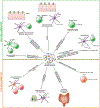Genetic Factors and the Intestinal Microbiome Guide Development of Microbe-Based Therapies for Inflammatory Bowel Diseases
- PMID: 30880022
- PMCID: PMC6568267
- DOI: 10.1053/j.gastro.2019.03.017
Genetic Factors and the Intestinal Microbiome Guide Development of Microbe-Based Therapies for Inflammatory Bowel Diseases
Abstract
The intestinal microbiota is a dynamic community of bacteria, fungi, and viruses that mediates mucosal homeostasis and physiology. Imbalances in the microbiome and aberrant immune responses to gut bacteria can disrupt homeostasis and are associated with inflammatory bowel diseases (IBDs) in humans and colitis in mice. We review genetic variants associated with IBD and their effects on the intestinal microbiome, the immune response, and disease pathogenesis. The intestinal microbiome, which includes microbial antigens, adjuvants, and metabolic products, affects the development and function of the intestinal mucosa, influencing inflammatory responses in the gut. Therefore, strategies to manipulate the microbiome might be used in treatment of IBD. We review microbe-based therapies for IBD and the potential to engineer patients' intestinal microbiota. We discuss how studies of patients with IBD and mouse models have advanced our understanding of the interactions between genetic factors and the gut microbiome, and challenges to the development of microbe-based therapies for IBD.
Keywords: Host Genetics; Inflammatory Bowel Disease; Microbiome; Mucosal Immunity; Preclinical Therapies.
Copyright © 2019 AGA Institute. Published by Elsevier Inc. All rights reserved.
Conflict of interest statement
Conflicts of Interest: D.G. is employed by Janssen which has invested or licensed products from Vedanta, BiomX and Enterome.
Figures



Similar articles
-
Inflammatory Bowel Diseases (IBD) and the Microbiome-Searching the Crime Scene for Clues.Gastroenterology. 2021 Jan;160(2):524-537. doi: 10.1053/j.gastro.2020.09.056. Epub 2020 Nov 27. Gastroenterology. 2021. PMID: 33253681 Free PMC article. Review.
-
The Microbiota and the Immune Response: What Is the Chicken and What Is the Egg?Gastrointest Endosc Clin N Am. 2019 Jul;29(3):381-393. doi: 10.1016/j.giec.2019.02.005. Epub 2019 Apr 5. Gastrointest Endosc Clin N Am. 2019. PMID: 31078242 Review.
-
Therapeutic Advances in Gut Microbiome Modulation in Patients with Inflammatory Bowel Disease from Pediatrics to Adulthood.Int J Mol Sci. 2021 Nov 19;22(22):12506. doi: 10.3390/ijms222212506. Int J Mol Sci. 2021. PMID: 34830388 Free PMC article. Review.
-
Recent advances in gut Microbiota mediated therapeutic targets in inflammatory bowel diseases: Emerging modalities for future pharmacological implications.Pharmacol Res. 2019 Oct;148:104344. doi: 10.1016/j.phrs.2019.104344. Epub 2019 Aug 7. Pharmacol Res. 2019. PMID: 31400403 Review.
-
Manipulating resident microbiota to enhance regulatory immune function to treat inflammatory bowel diseases.J Gastroenterol. 2020 Jan;55(1):4-14. doi: 10.1007/s00535-019-01618-1. Epub 2019 Sep 3. J Gastroenterol. 2020. PMID: 31482438 Free PMC article. Review.
Cited by
-
Diversion Colitis: Macro and Microscopic Findings after Probiotics Stimulation.Biology (Basel). 2021 Apr 6;10(4):303. doi: 10.3390/biology10040303. Biology (Basel). 2021. PMID: 33917556 Free PMC article.
-
Novel mechanisms and clinical trial endpoints in intestinal fibrosis.Immunol Rev. 2021 Jul;302(1):211-227. doi: 10.1111/imr.12974. Epub 2021 May 16. Immunol Rev. 2021. PMID: 33993489 Free PMC article. Review.
-
Mucosal DNA methylome alteration in Crohn's disease: surgical and non-surgical groups.Front Genet. 2023 Nov 17;14:1244513. doi: 10.3389/fgene.2023.1244513. eCollection 2023. Front Genet. 2023. PMID: 38046046 Free PMC article.
-
Mining the Microbiome and Microbiota-Derived Molecules in Inflammatory Bowel Disease.Int J Mol Sci. 2021 Oct 18;22(20):11243. doi: 10.3390/ijms222011243. Int J Mol Sci. 2021. PMID: 34681902 Free PMC article. Review.
-
Environmental and Microbial Factors in Inflammatory Bowel Disease Model Establishment: A Review Partly through Mendelian Randomization.Gut Liver. 2024 May 15;18(3):370-390. doi: 10.5009/gnl230179. Epub 2023 Oct 10. Gut Liver. 2024. PMID: 37814898 Free PMC article. Review.
References
-
- Hall AB, Tolonen AC, Xavier RJ. Human genetic variation and the gut microbiome in disease. Nat Rev Genet 2017;18:690–699. - PubMed
Publication types
MeSH terms
Substances
Grants and funding
LinkOut - more resources
Full Text Sources
Other Literature Sources

